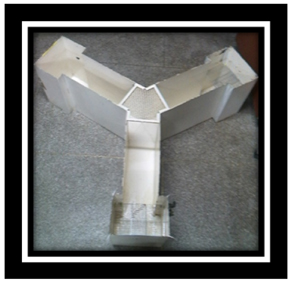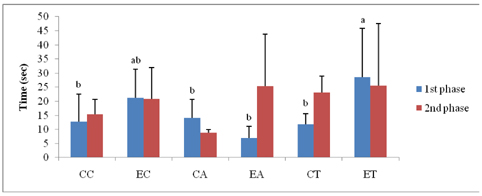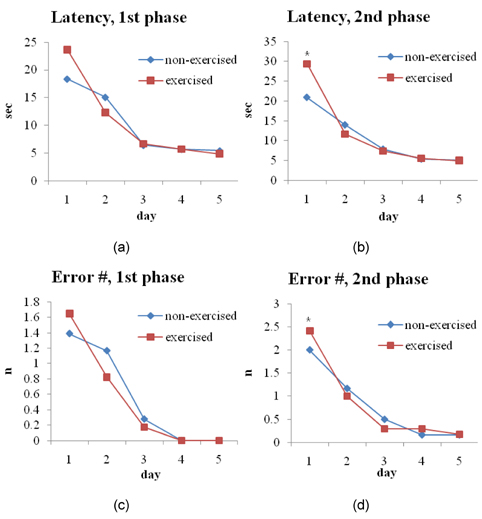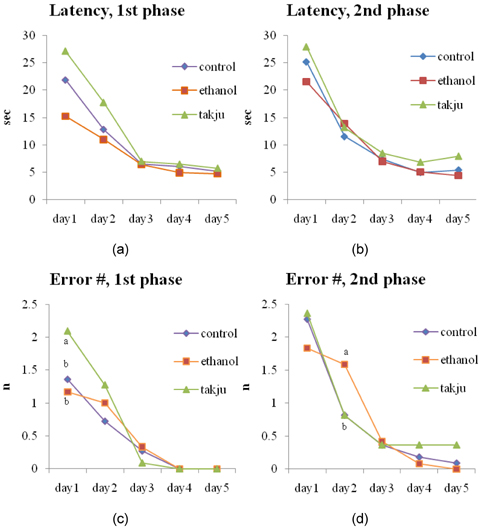Nutr Res Pract.
2011 Aug;5(4):294-300.
Effects of Takju intake and moderate exercise training on brain acetylcholinesterase activity and learning ability in rats
- Affiliations
-
- 1Department of Foods and Nutrition, Kookmin University, 861-1 Jeongneung-dong, Seongbuk-gu, Seoul 136-702, Korea. shkim@kookmin.ac.kr
Abstract
- Takju is a Korean alcoholic beverage made from rice, and is brewed with the yeast Saccharomyces cerevisiae. This study was conducted to evaluate the effects of exercise training and moderate Takju consumption on learning ability in 6-week old Sprague-Dawley male rats. The rats were treated with exercise and alcohol for 4 weeks in six separate groups as follows: non-exercised control (CC), exercised control (EC), non-exercised consuming ethanol (CA), exercised consuming ethanol (EA), non-exercised consuming Takju (CT), and exercised consuming Takju (ET). An AIN-93M diet was provided ad libitum. Exercise training was performed at a speed of 10 m/min for 15 minutes per day. Ethanol and Takju were administered daily for 6-7 hours to achieve an intake of about 10 ml after 12 hours of deprivation, and, thereafter, the animals were allowed free access to deionized water. A Y-shaped water maze was used from the third week to understand the effects of exercise and alcohol consumption on learning and memory. After sacrifice, brain acetylcholinesterase (AChE) activity was analyzed. Total caloric intake and body weight changes during the experiment were not significantly different among the groups. AChE activity was not significantly different among the groups. The number of errors for position reversal training in the maze was significantly smaller in the EA group than that in the CA and ET groups, and latency times were shorter in the EA group than those in the CC, EC, CT, and ET groups. The latency difference from the first to the fifth day was shortest in the ET group. The exercised groups showed more errors and latency than those of the non-exercised groups on the first day, but the data became equivalent from the second day. The results indicate that moderate exercise can increase memory and learning and that the combination of exercise and Takju ingestion may enhance learning ability.
Keyword
MeSH Terms
Figure
Reference
-
1. Yoo TJ. Korea Famous Wine. 1981. Seoul: Central New Book.2. Hong YH, Bae SH, Jung EY, Son HS, Shin KS, Kwon KH, Suh HJ. Radical scavenging activities of Korean traditional rice wine, Takju. J Food Sci Nutr. 2009. 14:109–115.
Article3. Kim JE, Jung SK, Lee SJ, Lee KW, Kim GW, Lee HJ. Nuruk extract inhibits lipopolysaccharide-induced production of nitrite and interleukin-6 in RAW 264.7 cells through blocking activation of p38 mitogen-activated protein kinase. J Microbiol Biotechnol. 2008. 18:1423–1426.4. Shin MO, Kang DY, Kim MH, Bae SJ. Effect of growth inhibition and quinone reductase activity stimulation of makgeoly fractions in various cancer cells. J Korean Soc Food Sci Nutr. 2008. 37:288–293.
Article5. Kim S, Cho W. Effects of Takju (Korean turbid rice wine) lees on the serum glucose levels in streptozotocin-induced diabetic rats. Korean J Food Cult. 2006. 21:638–643.6. Lee HS, Hong KH, Yoon CH, Kim JM, Kim SM. Effect of Korean turbid rice wine (Takju) lees extract on blood glucose in the db/db mouse. Korean J Food Cult. 2009. 24:219–223.7. Lee HS, Hong KH, Kim JY, Kim D, Yoon C, Kim SM. Blood pressure lowering effect of Korean turbid rice wine (Takju) lees extracts in spontaneously hypertensive rat (SHR). Korean J Food Cult. 2009. 24:338–343.8. Hu FB, Stampfer MJ, Colditz GA, Ascherio A, Rexrode KM, Willett WC, Manson JE. Physical activity and risk of stroke in women. JAMA. 2000. 283:2961–2967.
Article9. Barry HC, Eathorne SW. Exercise and aging. Issues for the practitioner. Med Clin North Am. 1994. 78:357–376.
Article10. Cobbs EL, Ralapati AN. Health of older women. Med Clin North Am. 1998. 82:127–144.
Article11. Williams P, Lord SR. Effects of group exercise on cognitive functioning and mood in older women. Aust N Z J Public Health. 1997. 21:45–52.
Article12. Emery CF, Gatz M. Psychological and cognitive effects of an exercise program for community-residing older adults. Gerontologist. 1990. 30:184–188.
Article13. McMurdo ME, Burnett L. Randomised controlled trial of exercise in the elderly. Gerontology. 1992. 38:292–298.
Article14. Rogers RL, Meyer JS, Mortel KF. After reaching retirement age physical activity sustains cerebral perfusion and cognition. J Am Geriatr Soc. 1990. 38:123–128.
Article15. Okumiya K, Matsubayashi K, Wada T, Kimura S, Doi Y, Ozawa T. Effects of exercise on neurobehavioral function in community-dwelling older people more than 75 years of age. J Am Geriatr Soc. 1996. 44:569–572.
Article16. Sutoo D, Akiyama K. Regulation of brain function by exercise. Neurobiol Dis. 2003. 13:1–14.
Article17. Kramer AF, Hahn S, Cohen NJ, Banich MT, McAuley E, Harrison CR, Chason J, Vakil E, Bardell L, Boileau RA, Colcombe A. Ageing, fitness and neurocognitive function. Nature. 1999. 400:418–419.
Article18. Fordyce DE, Wehner JM. Effects of aging on spatial learning and hippocampal protein kinase C in mice. Neurobiol Aging. 1993. 14:309–317.
Article19. Lasner M, Roth LG, Chen CH. Structure-functional effects of a series of alcohols on acetylcholinesterase-associated membrane vesicles: elucidation of factors contributing to the alcohol action. Arch Biochem Biophys. 1995. 317:391–396.
Article20. Iyo M, Namba H, Fukushi K, Shinotoh H, Nagatsuka S, Suhara T, Sudo Y, Suzuki K, Irie T. Measurement of acetylcholinesterase by positron emission tomography in the brains of healthy controls and patients with Alzheimer's disease. Lancet. 1997. 349:1805–1809.
Article21. Kwak JH, Jeong CH, Kim JH, Choi GN, Shin YH, Lee SC, Cho SH, Choi SG, Heo HJ. Acetylcholinesterase inhibitory effect of green tea extracts according to storage condition. Korean J Food Sci Technol. 2009. 41:435–440.22. Laurin D, Verreault R, Lindsay J, MacPherson K, Rockwood K. Physical activity and risk of cognitive impairment and dementia in elderly persons. Arch Neurol. 2001. 58:498–504.
Article23. Rosenzweig MR, Krech D, Bennett EL. Harlow HF, Woolsey CN, editors. Brain chemistry and adaptive behavior. Biological and Biochemical Bases of Behavior. 1958. Madison: University of Wisconsin Press;367–400.24. Krech D, Rosenzweig MR, Bennett EL. Dimensions of discrimination and level of cholinesterase activity in the cerebral cortex of the rat. J Comp Physiol Psychol. 1956. 49:261–268.
Article25. Krech D, Rosenzweig MR, Bennett EL. Effects of environmental complexity and training on brain chemistry. J Comp Physiol Psychol. 1960. 53:509–519.
Article26. Rosenzweig MR, Krech D, Bennett EL. Heredity, environment, brain biochemistry and learning. Current Trends in Psychological Theory. 1961. Pittsburgh: University of Pittsburgh Press;87–110.27. Blomqvist O, Söderpalm B, Engel JA. Ethanol-induced locomotor activity: involvement of central nicotinic acetylcholine receptors? Brain Res Bull. 1992. 29:173–178.
Article28. Reeves PG, Nielsen FH, Fahey GC Jr. AIN-93 purified diets for laboratory rodents: final report of the American Institute of Nutrition ad hoc writing committee on the reformulation of the AIN-76A rodent diet. J Nutr. 1993. 123:1939–1951.
Article29. Choi MJ. Effect of exercise and calcium supplementation on bone mineral density and bone mineral content in growing female rats. J Community Nutr. 2002. 4:195–201.30. Shepherd RE, Gollnick PD. Oxygen uptake of rats at different work intensities. Pflugers Arch. 1976. 362:219–222.
Article31. Dantzer R. Cytokine-induced sickness behavior: where do we stand? Brain Behav Immun. 2001. 15:7–24.
Article32. Oh HK, Kim SH. Effect of soy isoflavone intake on water maze performance and brain acetylcholinesterase activity in rats. Korean J Nutr. 2006. 39:219–224.33. Ellman GL, Courtney KD, Andres V Jr, Feather-Stone RM. A new and rapid colorimetric determination of acetylcholinesterase activity. Biochem Pharmacol. 1961. 7:88–95.
Article34. Marchand A, Chapouthier G, Massoulié J. Developmental aspects of acetylcholinesterase activity in chick brain. FEBS Lett. 1977. 78:233–236.
Article35. Wen G, Hui W, Dan C, Xiao-Qiong W, Jian-Bin T, Chang-Qi L, De-Liang L, Wei-Jun C, Zhi-Yuan L, Xue-Gang L. The effects of exercise-induced fatigue on acetylcholinesterase expression and activity at rat neuromuscular junctions. Acta Histochem Cytochem. 2009. 42:137–142.
Article36. Kwak YS, Um SY, Kim DE, Hwang HJ. The effect of different type of exercise on SOD, neutrophils and T lymphocytes. Immune Netw. 2005. 5:232–236.
Article37. Monteiro R, Faria A, Mateus N, Calhau C, Azevedo I. Red wine interferes with oestrogen signalling in rat hippocampus. J Steroid Biochem Mol Biol. 2008. 111:74–79.
Article38. Husain K, Somani SM. Effect of exercise training and chronic ethanol digestion on cholinesterase activity and lipid peroxtoation in blood and brain regions of rat. Prog Neuropsychopharmacol Biol Psychiatry. 1998. 22:411–423.
Article39. Appleyard ME, Taylor SC, Little HJ. Acetylcholinesterase activity in regions of mouse brain following acute and chronic treatment with a benzodiazepine inverse agonist. Br J Pharmacol. 1990. 101:599–604.
Article40. Husain K, Vijayaraghavan R. DFP induced changes in acetylcholinesterase activity and glycogen level in certain brain regions of mice. Indian J Physiol Pharmacol. 1989. 33:250–252.41. Somani SM, Babu SR, Arneric SP, Dube SN. Effect of cholinesterase inhibitor and exercise on choline acetyltransferase and acetylcholinesterase activities in rat brain regions. Pharmacol Biochem Behav. 1991. 39:337–343.
Article42. Krech D, Rosenzweig MR, Bennett EL. Dimensions of discrimination and level of cholinesterase activity in the cerebral cortex of the rat. J Comp Physiol Psychol. 1956. 49:261–268.
Article43. Krech D, Rosenzweig MR, Bennett EL. Effects of environmental complexity and training on brain chemistry. J Comp Physiol Psychol. 1960. 53:509–519.
Article44. Beiko J, Lander R, Hampson E, Boon F, Cain DP. Contribution of sex differences in the acute stress response to sex differences in water maze performance in the rat. Behav Brain Res. 2004. 151:239–253.
Article45. Márquez C, Nadal R, Armario A. Responsiveness of the hypothalamic-pituitary-adrenal axis to different novel environments is a consistent individual trait in adult male outbred rats. Psychoneuroendocrinology. 2005. 30:179–187.
Article
- Full Text Links
- Actions
-
Cited
- CITED
-
- Close
- Share
- Similar articles
-
- Effect of Soy Isoflavone Intake on Water Maze Performance and Brain Acetylcholinesterase Activity in Rats
- The Effects of Donepezil, an Acetylcholinesterase Inhibitor, on Impaired Learning and Memory in Rodents
- Regular moderate exercise training can alter the urinary excretion of thiamin and riboflavin
- Treadmill Exercise Ameliorates Short-Term Memory Disturbance in Scopolamine-Induced Amnesia Rats
- The effects of physical training on antioxidative status under exercise-induced oxidative stress






